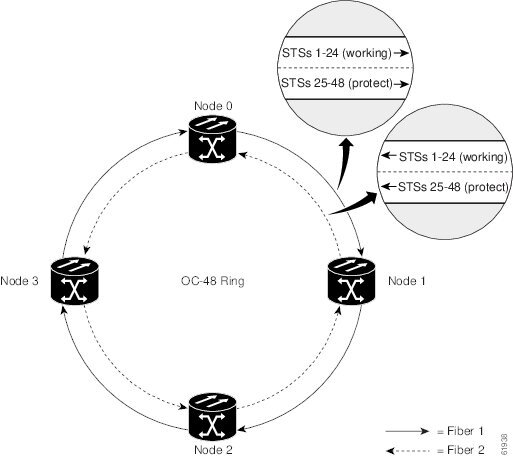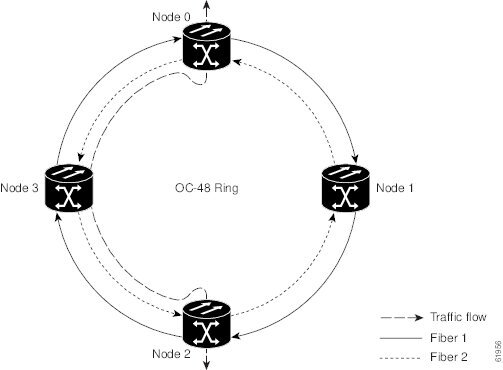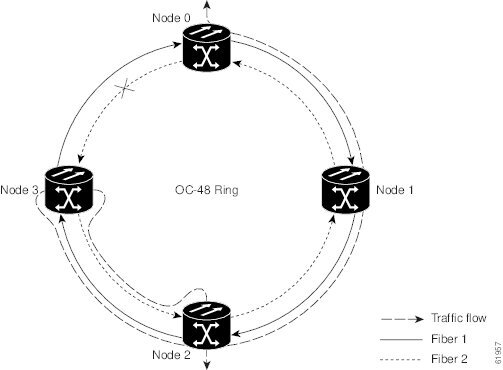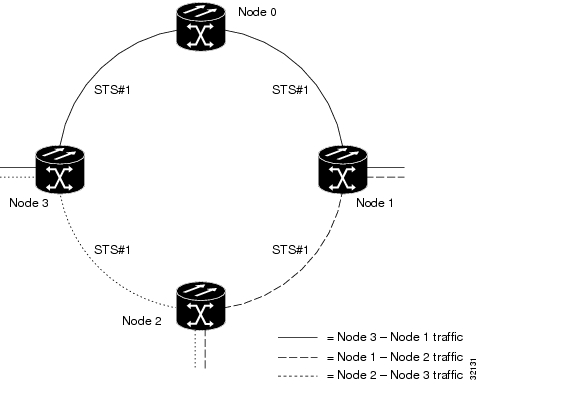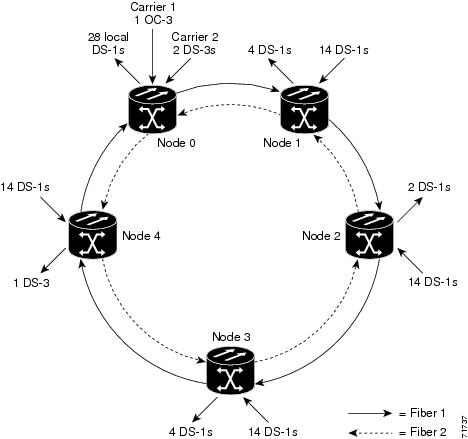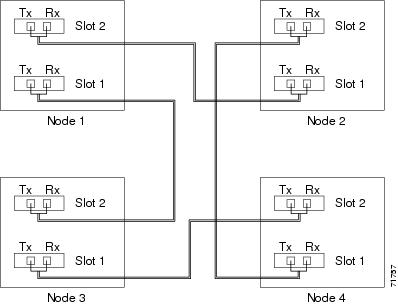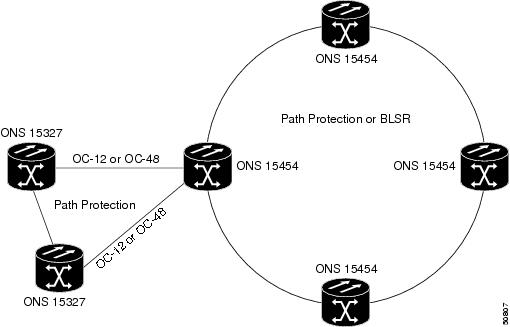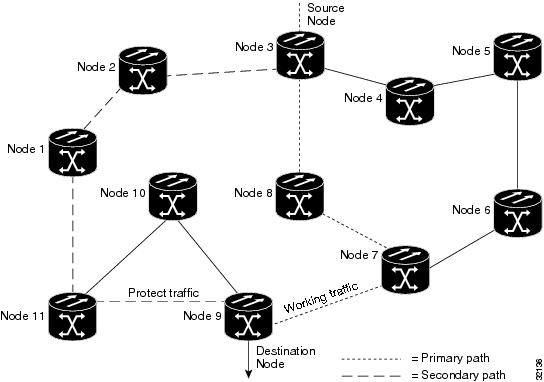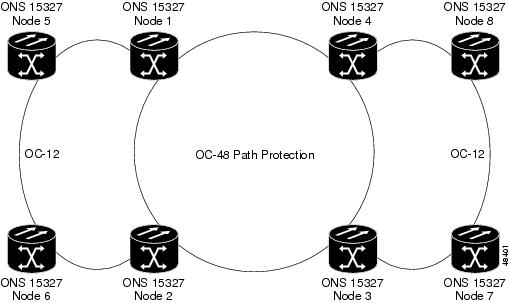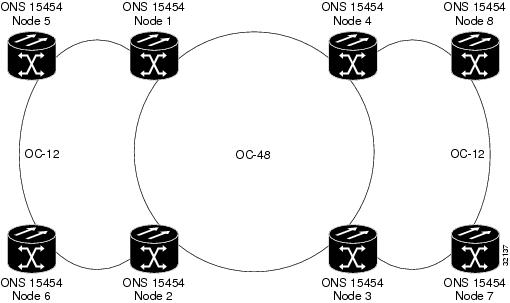 Feedback Feedback
|
Table Of Contents
7.1 Bidirectional Line Switched Rings
7.1.3 BLSR Application Example
7.1.5 Connecting ONS 15327 Nodes and ONS 15454 Nodes
7.2 Terminal Point-to-Point and Linear ADM Configurations
7.3 Path-Protected Mesh Networks
7.6 In-Service Topology Upgrades
7.6.1 Unprotected Point-to-Point or Linear ADM to Path Protection
7.6.2 Point-to-Point or Linear ADM to Two-Fiber BLSR
7.6.3 Path Protection to Two-Fiber BLSR
7.6.4 Add or Remove a Node from a Topology
SONET Topologies and Upgrades
Note
The terms "Unidirectional Path Switched Ring" and "UPSR" may appear in Cisco literature. These terms do not refer to using Cisco ONS 15xxx products in a unidirectional path switched ring configuration. Rather, these terms, as well as "Path Protected Mesh Network" and "PPMN," refer generally to Cisco's path protection feature, which may be used in any topological network configuration. Cisco does not recommend using its path protection feature in any particular topological network configuration.
This chapter explains Cisco ONS 15327 SONET topologies and upgrades. To provision topologies, refer to the Cisco ONS 15327 Procedure Guide.
Chapter topics include:
•
Bidirectional Line Switched Rings
•
Terminal Point-to-Point and Linear ADM Configurations
7.1 Bidirectional Line Switched Rings
One ONS 15327 can support two concurrent bidirectional line switched rings (BLSRs). Each BLSR can have up to 32 ONS 15327s. Because the working and protect bandwidths must be equal, you can create only OC-12 or OC-48 BLSRs. For information about BLSR protection channels, see the "BLSR Protection Channel Access Circuits" section.
Note
For best performance, BLSRs should have one LAN connection for every ten nodes in the BLSR.
7.1.1 BLSR Functionality
The Cisco ONS 15327 supports two-fiber BLSRs (the ONS 15454 also supports four-fiber BLSRs); each fiber in a two-fiber BLSR is divided into working and protect bandwidths. For example, in an OC-48 BLSR (Figure 7-1), STSs 1 to 24 carry the working traffic, and STSs 25 to 48 are reserved for protection. Working traffic (STSs 1 to 24) travels in one direction on one fiber and in the opposite direction on the second fiber. The Cisco Transport Controller (CTC) circuit routing routines calculate the shortest path for circuits based on many factors, including user requirements, traffic patterns, and distance. For example, in Figure 7-1, circuits going from Node 0 to Node 1 will typically travel on Fiber 1, unless that fiber is full, in which case circuits will be routed on Fiber 2 through Node 3 and Node 2. Traffic from Node 0 to Node 2 (or Node 1 to Node 3) can be routed on either fiber, depending on circuit provisioning requirements and traffic loads.
Figure 7-1 Four-Node BLSR
The SONET K1, K2, and K3 bytes carry the information that governs BLSR protection switches. Each BLSR node monitors the K bytes to determine when to switch the SONET signal to an alternate physical path. The K bytes communicate failure conditions and actions taken between nodes in the ring.
If a break occurs on one fiber, working traffic targeted for a node beyond the break switches to the protect bandwidth on the second fiber. The traffic travels in a reverse direction on the protect bandwidth until it reaches its destination node. At that point, traffic is switched back to the working bandwidth.
Figure 7-2 shows a traffic pattern example on a four-node BLSR.
Figure 7-2 Four-Node BLSR Traffic Pattern Example
Figure 7-3 shows how traffic is rerouted following a line break between Node 0 and Node 3.
•
All circuits originating on Node 0 carried traffic to Node 2 on Fiber 2 are switched to the protect bandwidth of Fiber 1. For example, a circuit carrying traffic on STS-1 on Fiber 2 is switched to STS-25 on Fiber 1. A circuit carried on STS-2 on Fiber 2 is switched to STS-26 on Fiber 1. Fiber 1 carries the circuit to Node 3 (the original routing destination). Node 3 switches the circuit back to STS-1 on Fiber 2 where it is routed to Node 2 on STS-1.
•
Circuits originating on Node 2 that normally carried traffic to Node 0 on Fiber 1 are switched to the protect bandwidth of Fiber 2 at Node 3. For example, a circuit carrying traffic on STS-2 on Fiber 1 is switched to STS-26 on Fiber 2. Fiber 2 carries the circuit to Node 0 where the circuit is switched back to STS-2 on Fiber 1 and then dropped to its destination.
Figure 7-3 Four-Node BLSR Traffic Pattern Following a Line Break
7.1.2 BLSR Bandwidth
BLSR nodes can terminate traffic coming from either side of the ring. Therefore, BLSRs are suited for distributed node-to-node traffic applications such as interoffice networks and access networks.
BLSRs allow bandwidth to be reused around the ring and can carry more traffic than a network with traffic flowing through one central hub. BLSRs can also carry more traffic than a path protection operating at the same OC-N rate. Table 7-1 shows the bidirectional bandwidth capacities of BLSRs. The capacity is the OC-N rate divided by two, multiplied by the number of nodes in the ring minus the number of pass-through STS-1 circuits.
Table 7-1 BLSR Capacity
OC-12
STS1-6
STS 7-12
OC-48
STS 1-24
STS 25-48
24 x N - PT
1 N is the number of ONS 15327 nodes configured as BLSR nodes.
2 PT is the number of STS-1 circuits passed through ONS 15327 nodes in the ring (capacity can vary depending on the traffic pattern).
Figure 7-4 shows an example of BLSR bandwidth reuse. The same synchronous transport signal (STS) carries three different traffic sets simultaneously on different spans around the ring: one set from Node 3 to Node 1, another set from Node 1 to Node 2, and another set from Node 2 to Node 3.
Figure 7-4 BLSR Bandwidth Reuse
7.1.3 BLSR Application Example
Figure 7-5 shows a BLSR implementation example. A regional long-distance network connects to other carriers at Node 0. Traffic is delivered to the service provider's major hubs.
•
Carrier 1 delivers two DS-3s over one OC-3 spans to Node 0. Carrier 2 provides two DS-3s directly. Node 0 receives the signals and delivers them around the ring to the appropriate node.
•
The ring also brings 14 DS-1s back from each remote site to Node 0. Intermediate nodes serve these shorter regional connections.
•
The ONS 15327 OC-3 card supports a total of four OC-3 ports so that two additional OC-3 spans can be added at little cost.
Figure 7-5 Five-Node BLSR
Figure 7-6 shows the shelf assembly layout for Node 0, which has no free slots.
Figure 7-6 Shelf Assembly Layout for Node 0 in Figure 7-5
Figure 7-7 shows the shelf assembly layout for the remaining sites in the ring. In this BLSR configuration, an additional three DS-3s at Nodes 1, 2, 3, and 4 can be activated. Each site has free slots for future traffic needs.
Figure 7-7 Shelf Assembly Layout for Nodes 1 to 4 in Figure 7-5
7.1.4 BLSR Fiber Connections
Plan your fiber connections and use the same plan for all BLSR nodes. For example, make the east port the farthest slot to the right and the west port the farthest slot to the left. Plug fiber connected to an east port at one node into the west port on an adjacent node. Figure 7-8 shows fiber connections for a BLSR with trunk (span) cards in Slot 1 (west) and Slot 2 (east). See the Cisco ONS 15327 Procedure Guide for fiber connection procedures.
Note
Always plug the transmit (Tx) connector of an OC-N card at one node into the receive (Rx) connector of an OC-N card at the adjacent node. Cards display an signal fail (SF) LED when Tx and Rx connections are mismatched.
Figure 7-8 Connecting Fiber to a Four-Node, Two-Fiber BLSR
7.1.5 Connecting ONS 15327 Nodes and ONS 15454 Nodes
You can install ONS 15327 nodes into a network comprised entirely of ONS 15327 nodes or into a network that has a mix of ONS 15327 and ONS 15454 nodes. The ONS 15327 interoperates with the ONS 15454 in linear, path protection, and 2-fiber BLSR configurations. Because connection procedures for both types of nodes are the same (for example, adding or dropping nodes from a path protection or linear configuration, or creating DCCs), follow the instructions in the Cisco ONS 15327 Procedure Guide whenever you make connections between ONS 15454 and ONS 15327 nodes. Figure 7-9 shows a basic linear or path protection connection between ONS 15327 and ONS 15454 nodes.
Figure 7-9 Linear or Path Protection Connection between ONS 15454 and ONS 15327 Nodes
Figure 7-10 shows a ring of ONS 15327s subtended from a ring of ONS 15454s.
Figure 7-10 ONS 15327 Ring Subtended from an ONS 15454 Ring
7.2 Terminal Point-to-Point and Linear ADM Configurations
You can configure ONS 15327s in a terminal point-to-point network (2 nodes) or as a line of add/drop multiplexers (ADMs) (3 or more nodes) by configuring one set of OC-N cards as the working path and a second set as the protect path. Unlike rings, terminal and linear ADMs require that the OC-N cards at each node be in 1+1 protection to ensure that a break to the working line is automatically routed to the protect line.
Figure 7-11 shows three ONS 15327s in a linear ADM configuration. Working traffic flows from Slot 3/Node 1 to Slot 3/Node 2, and from Slot 2/Node 2 to Slot 2/Node 3. You create the protect path by placing Slot 3 in 1+1 protection with Slot 1 at Nodes 1 and 2, and Slot 2 in 1+1 protection with Slot 4 at Nodes 2 and 3.
Figure 7-11 Linear ADM Configuration
7.3 Path-Protected Mesh Networks
In addition to single BLSRs, path protection configurations and terminal point-to-point or linear ADMs, you can extend ONS 15327 traffic protection by creating path-protected mesh networks (PPMNs). PPMNs include multiple ONS 15327 SONET topologies and extend the protection provided by a single path protection to the meshed architecture of several interconnecting rings. In a PPMN, circuits travel diverse paths through a network of single or multiple meshed rings. When you create circuits, you can have CTC automatically route circuits across the PPMN, or you can manually route them. You can also choose levels of circuit protection. For example, if you choose full protection, CTC creates an alternate route for the circuit in addition to the main route. The second route follows a unique path through the network between the source and destination and sets up a second set of cross-connections.
For example, in Figure 7-12, a circuit is created from Node 3 to Node 9. CTC determines that the shortest route between the two nodes passes through Node 8 and Node 7, shown by the dotted line, and automatically creates cross-connections at Nodes 3, 8, 7, and 9 to provide the primary circuit path.
If full protection is selected, CTC creates a second unique route between Nodes 3 and 9 which, in this example, passes through Nodes 2, 1, and 11. Cross-connections are automatically created at Nodes 3, 2, 1, 11, and 9, shown by the dashed line. If a failure occurs on the primary path, traffic switches to the second circuit path. In this example, Node 9 switches from the traffic coming in from Node 7 to the traffic coming in from Node 11 and service resumes. The switch occurs within 50 ms.
Figure 7-12 Path-Protected Mesh Network
PPMN also allows spans with different SONET speeds to be mixed together in "virtual rings." Figure 7-13 shows Nodes 1, 2, 3, and 4 in a standard OC-48 ring. Nodes 5, 6, 7, and 8 link to the backbone ring through OC-12 fiber. The "virtual ring" formed by Nodes 5, 6, 7, and 8 uses both OC-48 and OC-12 cards.
Figure 7-13 PPMN Virtual Ring
7.4 Four Node Configurations
You can link multiple ONS 15327s using their OC-N cards (also known as creating a fiber-optic bus) to accommodate more access traffic than a single ONS 15327 can support. For example, to drop more than 28 DS-1s or 3 DS-3s (the maximum that can be aggregated in a single node), you can link the nodes but not merge multiple nodes into a single ONS 15327. You can link nodes with OC-12 or OC-48 fiber spans as you would link any other two network nodes. The nodes can be grouped in one facility to aggregate more local traffic.
7.5 OC-N Speed Upgrades
A span is the optical fiber connection between two ONS 15327 nodes. In a span (optical speed) upgrade, the transmission rate of a span is upgraded from a lower to a higher OC-N signal but all other span configuration attributes remain unchanged. With multiple nodes, a span upgrade is a coordinated series of upgrades on all nodes in the ring or protection group.
To perform a span upgrade, the higher-rate optical card must replace the lower-rate card in the same slot. All spans in the network must be upgraded. The protection configuration of the original lower-rate optical card (BLSR, path protection, and 1+1) is retained for the higher-rate optical card.
When performing span upgrades on a large number of nodes, Cisco recommends that you upgrade all spans in a network consecutively and in the same maintenance window. Until all spans are upgraded, mismatched card types will be present.
Cisco recommends using the Span Upgrade Wizard to perform span upgrades. Although you can also use the manual span upgrade procedures, the manual procedures are mainly provided as error recovery for the wizard. The Span Upgrade Wizard and the manual span upgrade procedures require at least two technicians (one at each end of the span) who can communicate with each other during the upgrade. Upgrading a span is non-service affecting and will cause no more than three switches, each of which is less than 50 ms in duration.
Note
Span upgrades do not upgrade SONET topologies, for example, a 1+1 group to a BLSR. See the Cisco ONS 15327 Procedure Guide for topology upgrade procedures.
7.5.1 Span Upgrade Wizard
The Span Upgrade Wizard automates all steps in the manual span upgrade procedure (BLSR, path protection, and 1+1). The wizard can upgrade both lines of a 1+1 group; the wizard upgrades path protections and BLSRs one line at a time. The Span Upgrade Wizard requires that spans have DCCs enabled.
The Span Upgrade Wizard provides no way to back out of an upgrade. In the case of an error, you must exit the wizard and initiate the manual procedure to either continue with the upgrade or back out of it. To continue with the manual procedure, examine the standing conditions and alarms to identify the stage in which the wizard failure occurred.
7.5.2 Manual Span Upgrades
Manual span upgrades are mainly provided as error recovery for the Span Upgrade Wizard, but they can be used to perform span upgrades. You can perform a manual span upgrade on a BLSR, path protection, and on a 1+1 protection group.
Downgrading can be performed to back out of a span upgrade. The procedure for downgrading is the same as upgrading except that you choose a lower-rate card type and install a lower-rate card. You cannot downgrade if circuits exist on the STSs that will be removed (the higher STSs).
7.6 In-Service Topology Upgrades
Topology upgrades can be performed in-service to convert a live network to a different topology. An in-service topology upgrade is potentially service-affecting, and generally allows a traffic hit of 50 ms or less. Traffic may not be protected during the upgrade. The following in-service topology upgrades are supported:
•
Unprotected point-to-point or linear ADM to path protection
•
Point-to-point or linear ADM to two-fiber BLSR
•
Path protection to two-fiber BLSR
•
Node addition or removal from an existing topology
You can perform in-service topology upgrades irrespective of the service state of the involved cross-connects or circuits, however a circuit must have a DISCOVERED status.
Circuit types supported for in-service topology upgrades are:
•
STS, VT, and VT tunnels
•
VCAT
•
Unidirectional and bidirectional
•
Automatically routed and manually routed
•
CTC-created and TL1-created
•
Ethernet (unstitched)
•
Multiple source and destination (both sources should be on one node and both drops on one node)
You cannot upgrade stitched Ethernet circuits during topology conversions. For in-service topology upgrade procedures, refer to the "Convert Network Configurations" chapter in the Cisco ONS 15327 Procedure Guide. For procedures to add or remove a node, refer to the "Add and Remove Nodes" chapter of the Cisco ONS 15327 Procedure Guide.
Note
A database restore on all nodes in a topology returns converted circuits to their original topology.
Note
Open-ended path protection and DRI configurations do not support in-service topology upgrades.
7.6.1 Unprotected Point-to-Point or Linear ADM to Path Protection
CTC provides a topology conversion wizard for converting an unprotected point-to-point or linear ADM topology to path protection. This conversion occurs at the circuit level. CTC calculates the additional path protection circuit route automatically or you can do it manually. When routing the path protection circuit, you can provision the USPR as go-and-return or unidirectional.
When performing an in-service topology upgrade on a configuration with VCAT circuits, CTC allows you to select member circuits to upgrade individually. When upgrading VT tunnels, CTC does not convert the VT tunnel to path protection, but instead creates a secondary tunnel for the alternate path. The result is two unprotected VT tunnels using alternate paths.
To convert from point-to-point or linear ADM to a path protection, the topology requires an additional circuit route to complete the ring. When the route is established, CTC creates circuit connections on any intermediate nodes and modifies existing circuit connections on the original circuit path. The number and position of network spans in the topology remains unchanged during and after the conversion.
Figure 7-14 shows an unprotected point-to-point ADM configuration converted to a path protection. An additional circuit routes through Node 3 to complete the path protection.
Figure 7-14 Unprotected Point-to-Point ADM to Path Protection Conversion
7.6.2 Point-to-Point or Linear ADM to Two-Fiber BLSR
A 1+1 point-to-point or linear ADM to a two-fiber BLSR conversion is manual. You must remove the protect fibers from all nodes in the linear ADM and route them from the end node to the protect port on the other end node. In addition, you must delete the circuit paths that are located in the bandwidth that will become the protection portion of the two-fiber BLSR and recreate them in the appropriate bandwidth. Finally, you must provision the nodes as BLSR nodes.
To complete a conversion from an unprotected point-to-point or linear ADM to a two-fiber BLSR, use the CTC Convert Unprotected/path protection to BLSR wizard from the Tools > Topology Upgrade menu.
7.6.3 Path Protection to Two-Fiber BLSR
CTC provides a topology conversion wizard to convert a path protection to a two-fiber BLSR. An upgrade from a path protection to a two-fiber BLSR changes path protection to line protection. A path protection can have a maximum of 16 nodes before conversion. Circuits paths must occupy the same time slots around the ring. Only the primary path through the path protection is needed; the topology conversion wizard removes the alternate path protection path during the conversion. Because circuit paths can begin and end outside of the topology, the conversion might create line-protected segments within path protection paths of circuits outside the scope of the ring. The physical arrangement of the ring nodes and spans remains the same after the conversion.
7.6.4 Add or Remove a Node from a Topology
You can add or remove a node from a linear ADM, BLSR, or path protection configuration. Adding or removing nodes from BLSRs is potentially service affecting, however adding and removing nodes from an existing 1+1 linear ADM or path protection configuration does not disrupt traffic. CTC provides a wizard for adding a node to a point-to-point or 1+1 linear ADM. This wizard is used when adding a node between two other nodes.

